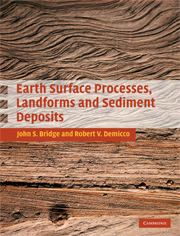Book contents
- Frontmatter
- Contents
- Acknowledgments
- Figure credits
- PART 1 Introduction
- PART 2 Production of sediment at the Earth's surface
- PART 3 Fundamentals of fluid flow, sediment transport, erosion, and deposition
- 5 Unidirectional turbulent water flow, sediment transport, erosion, and deposition
- 6 Air flow, sediment transport, erosion, and deposition
- 7 Multidirectional water flow, sediment transport, erosion, and deposition
- 8 Movement of sediment by gravity
- 9 Generation and movement of volcaniclastic sediment
- 10 Ice flow, sediment transport, erosion, and deposition
- 11 Biogenic and chemogenic depositional structures
- 12 Post-depositional deformation of soft sediment
- PART 4 Environments of erosion and deposition
- PART 5 Sediment into rock: diagenesis
- PART 6 Long-term, large-scale processes: mountains and sedimentary basins
- References
- Appendix: Methods of study of Earth surface processes, landforms, and sediments
- Index
- Plate section
5 - Unidirectional turbulent water flow, sediment transport, erosion, and deposition
from PART 3 - Fundamentals of fluid flow, sediment transport, erosion, and deposition
Published online by Cambridge University Press: 05 June 2012
- Frontmatter
- Contents
- Acknowledgments
- Figure credits
- PART 1 Introduction
- PART 2 Production of sediment at the Earth's surface
- PART 3 Fundamentals of fluid flow, sediment transport, erosion, and deposition
- 5 Unidirectional turbulent water flow, sediment transport, erosion, and deposition
- 6 Air flow, sediment transport, erosion, and deposition
- 7 Multidirectional water flow, sediment transport, erosion, and deposition
- 8 Movement of sediment by gravity
- 9 Generation and movement of volcaniclastic sediment
- 10 Ice flow, sediment transport, erosion, and deposition
- 11 Biogenic and chemogenic depositional structures
- 12 Post-depositional deformation of soft sediment
- PART 4 Environments of erosion and deposition
- PART 5 Sediment into rock: diagenesis
- PART 6 Long-term, large-scale processes: mountains and sedimentary basins
- References
- Appendix: Methods of study of Earth surface processes, landforms, and sediments
- Index
- Plate section
Summary
Introduction
Unidirectional, turbulent water flow is probably the most important agent of erosion, sediment transport, and deposition on land. Together with sediment gravity flows, unidirectional water flows are the prime sculptors of the land surface, with air and ice flows of secondary importance. Water may flow in channels or as sheet-like flows over floodplains and hillslopes. However, unidirectional water flows also occur in the sea and lakes. This chapter deals with principles of unidirectional water flow, sediment transport and bed forms, erosion, and deposition. These principles are also relevant to unidirectional air flows and sediment gravity flows, and even periodically reversing water flows, as discussed in subsequent chapters. The extensive published literature on this subject is spread over the disciplines of Earth science, engineering, and physics. Useful reviews of various aspects of this subject are given in Allen (1982a, 1985), Best (1993, 1996), Bridge (2003), Leeder (1999), Middleton and Wilcock (1994), Nezu and Nakagawa (1993), Van Rijn (1990, 1993), and Yalin (1992).
Fundamentals of unidirectional water flow
Definition of physical properties of water and its motion
The physical properties of water that are of most concern here are density and viscosity, both of which depend on temperature. The flow of water is normally described in terms of depth, width, cross-sectional area, velocity, discharge, bed shear stress, Reynolds number, and Froude number. Methods of measurement of fluid flows are discussed in the appendix.
- Type
- Chapter
- Information
- Earth Surface Processes, Landforms and Sediment Deposits , pp. 121 - 194Publisher: Cambridge University PressPrint publication year: 2008
- 2
- Cited by



